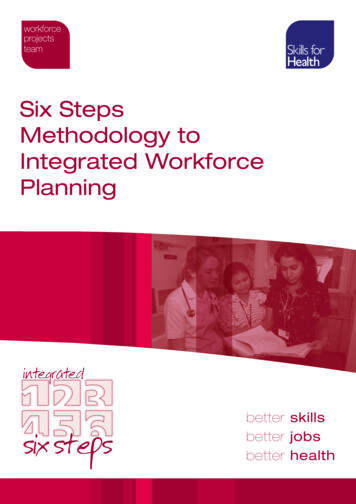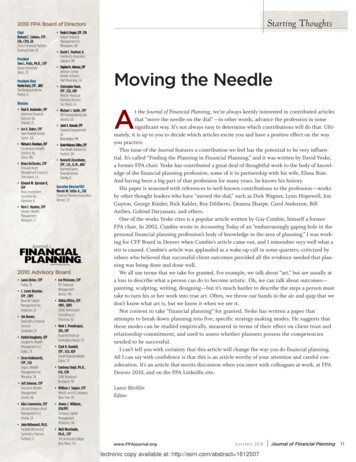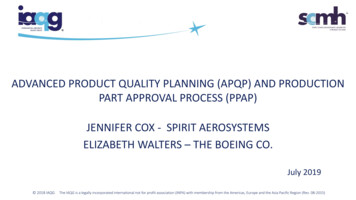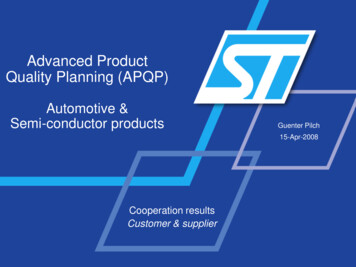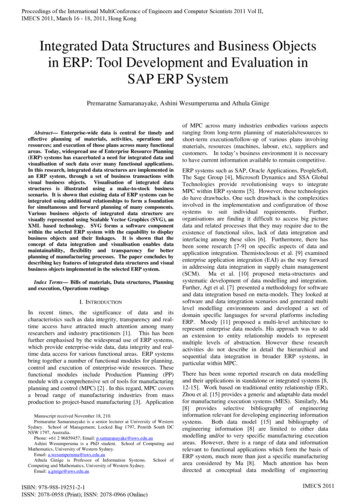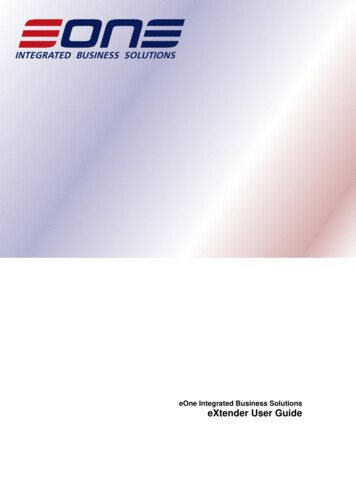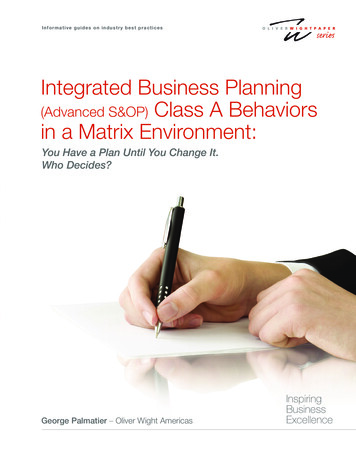
Transcription
Infor mative gu i des on i n du s t r y bes t pr ac t ic e sIntegrated Business Planning(Advanced S&OP) Class A Behaviorsin a Matrix Environment:You Have a Plan Until You Change It.Who Decides?George Palmatier – Oliver Wight AmericasInspiringBusinessExcellence
You Have a Plan UntilYou Change It QUESTION:How do you keep one set of numbers ina matrix environment when the entirecompany does not have an integratedbusiness management process, e.g., Salesand Operations Planning or IntegratedBusiness Planning (Advanced S&OP)?CLASS A PRINCIPLE:At the leadership level, you have a planuntil you change it! The plan can only bechanged through the Integrated BusinessPlanning (Advanced S&OP) process and isnot a new plan until changes are reviewedand approved through the formalIntegrated Business Planning (AdvancedS&OP) process in accordance with theprocess policy and procedures.WHAT IS THE ISSUE?In a matrix environment, it is common thatthe Integrated Business Planning(Advanced S&OP) process step ownershave dual reporting -- one, to the Presidentor General Manager of the business unitwithin which they operate; and two, to afunctional leader who often has geographic orglobal responsibility for a function.2INTEGRATED BUSINESS PLANNING (ADVANCED S&OP) CLASS A BEHAVIORS IN A MATRIX ENVIRONMENT
It is not uncommon that the operationalbusiness unit will be operating to anagreed-upon Integrated Business PlanningDefinition of Integrated Business Planning(Advanced S&OP)(Advanced S&OP) plan updated in the lastmonthly cycle or special update per the“emergency changes” procedure of theformal Integrated Business Planning(Advanced S&OP) process. This, of course,keeps the operating business aligned,synchronized, and operating to one set ofconsensus numbers.Sometimes a global functional leaderindependently directs a local function tomake changes to the operating business unit A process led by senior management that evaluates and revises time-phasedprojections for demand, supply, product and portfolio changes, strategicprojects, and the resulting financial plans. This is done on a monthly basis,typically over a 24-month rolling planning horizon. It is a decision-making process that realigns the tactical plans for all businessfunctions in all geographies and operating units to support the company’s businessgoals and targets. A primary objective of Integrated Business Planning (Advanced S&OP) isto reach consensus on a single operating plan, to which executives of themanagement team hold themselves accountable and allocates the criticalresources of people, equipment, inventory, materials, time, and money to mosteffectively satisfy customers in a profitable way.plans or changes to targets, (e.g., productdevelopment plans, demand plans, supplyplans, inventory plans, goals, or targets).When this occurs, the Integrated BusinessPlanning (Advanced S&OP) process stepowner for the operating unit (e.g., VP R&D,VP Demand, VP Supply etc.) is faced withconflicting directions. He or she has theconsensus Integrated Business Planning(Advanced S&OP) plan for the operatingunit directed by the local leadership andnew direction from a central authority.CLASS A PRINCIPLE:There can only be one planning andcontrol system; when there is more than oneplanning and control system, in realitythere is none. Misalignment, nonsynchronization, and chaos occur.INTEGRATED BUSINESS PLANNING (ADVANCED S&OP) CLASS A BEHAVIORS IN A MATRIX3
What Is Class AInformal, ”order launch and expedite”systems then predominate with their inherent lower performance and higher costs.Class A is a term coined by Oliver Wight and adapted by many companies in avariety of industries to depict best practices. The term originated from the Class Achecklists that have been published by Oliver Wight since the 1970s.Now in its sixth edition, The Oliver Wight Class A Checklist for Business Excellencecontains best practice standards on the following business processes: Managing the Strategic Planning ProcessCLASS A PRINCIPLE:The operating business unit must operateto the consensus Integrated BusinessPlanning (Advanced S&OP) plan untilchanged through the Integrated BusinessPlanning (Advanced S&OP) process Managing and Leading Peopleaccording to the agreed-upon process Driving Business Improvementpolicy and procedure. This means that Integrated Business Management(Sales and Operations Planning) Managing Products and Services Managing Demandthe global functional leader can requestchanges, but changes are subject toconsensus approval by the leadership ofthe operating business unit in accordancewith S&OP policy and procedure. Managing the Supply Chain Managing Internal Supply Managing External ResourcingTo order your copy of the checklist,http://www.oliverwight-americas.com/ow library.CLASS A BEHAVIORS1. The operating business unit shouldrecognize direction from globalfunctions as inputs subject to reviewand approval through theIntegrated Business PlanningThe global functional leader can requestchanges, but changes are subject toconsensus approval by the leadershipof the operating business unit.(Advanced S&OP) process.The leadership members of theoperating business unit must respectthe inputs from global functionalleaders but should include thoseinputs in the Integrated BusinessPlanning (Advanced S&OP) cycle.4INTEGRATED BUSINESS PLANNING (ADVANCED S&OP) CLASS A BEHAVIORS IN A MATRIX ENVIRONMENT
Figure 1. One Example of Consolidated Integrated Business Planning (Advanced S&OP)Level 3GlobalGlobal teReviewLevel 2Region/Business liationSenior ManagerReviewLevel 1LocalCountry/MarketDemandPlanningWeek 1Week 2Week 3Week 4Caution should be taken to not im-mediately overreact to these inputs without cross-functional review.Overreaction inevitably leads to unnecessary work or rework.2. The Integrated Business Planning (Advanced S&OP) process step owners must communicate to the MBRmembers that represent the business unit when they receive conflicting direction from the global functionalleadership. Specifically, the owner of the Integrated Reconciliation step of the Integrated Business Planning(Advanced S&OP) process should be advised. He or she should then advise the appropriate executiveleaders of the directed or requested change either immediately or through the regularly scheduled IntegratedBusiness Planning (Advanced S&OP) process, depending upon the significance and urgency.3. The global functional leadership should view their communications as requests rather than absolute directives andshould respect the integrated management process of the operating business unit. In practice, the IntegratedBusiness Planning (Advanced S&OP) process provides an excellent forum to ensure that inputs and directives froma central functional organization are addressed through a disciplined, regular, and routine process. This helps ensurethat there are no surprise unintended consequences from implementing a functional directive without appropriatereview and analysis of the effect on the entire business.INTEGRATED BUSINESS PLANNING (ADVANCED S&OP) CLASS A BEHAVIORS IN A MATRIX5
4. In a mature Integrated Business Planning (Advanced S&OP) process, inputs from globalfunctional leaders are an input to the individual steps in the process and/or inputs “topdown” as changes to strategies or strategic goals. Changes to strategies or goals arehandled regularly and routinely through the Integrated Business Planning (AdvancedS&OP) process at the operating unit level.5. Significant conflict between direction from the global functional leadership and thelocal operating business unit function requires collaborative resolution withparticipation from the global functional leader, the local functional leader, and theoperating business unit leadership. If this collaboration still does not enable resolutionof the conflict, upper-level management should become involved as appropriate -always with the full facts and consequences of business choices highly visible to allinvolved.To talk to an Oliver Wight Integrated Business Planning (Advanced S&OP) expert onimplementing or improving Integrated Business Planning (Advanced S&OP), please contactwww.oliverwight-americas.com or call 800-258-3862.6INTEGRATED BUSINESS PLANNING (ADVANCED S&OP) CLASS A BEHAVIORS IN A MATRIX ENVIRONMENT
Infor mative gu i des on i n du s t r y bes t pr ac t ic e sABOUT THE AUTHORGeorge Palmatier, Oliver Wight Principal, has assisted many companies that makeeverything from soup to satellites in implementing integrated management processes.He is recognized as an expert on Sales & Operations Planning, Integrated Business Planningand demand management as well as ERP, Integrated Supply Chain Management,and Integrated Product Development (IPD). George works with clients to formalize andintegrate their strategic plans into an integrated business management process, IntegratedBusiness Planning. With twenty years of experience in sales, marketing, strategic planning,and general management, George has a thorough knowledge of how to achieve sustainedresults improving business performance. During his 11 years as vice-president of salesand marketing at Bently Nevada Corporation (now part of General Electric), George wasresponsible for bringing the sales and marketing departments into an integrated businessmanagement process. Bently Nevada was one of the pioneers in developing andimplementing Sales & Operations Planning using it in a truly integrated managementprocess. George has authored or co-authored four books: The Marketing Edge,Enterprise Sales and Operations Planning, Demand Management Best Practices, andThe Transition from Sales and Operations Planning to Integrated Business Planning.Oliver Wight Americas, IncAsia/PacificPO Box 368, 292 Main StreetNew London, New Hampshire 03257, USA131 Martin StreetBrighton, VIC 3186, ope, Africa & Middle w.oliverwight-americas.com Oliver Wight InternationalThe WillowsThe Steadings Business CentreMaisemore, Gloucester GL2 8EY, UKInspiringBusinessExcellence
Business Planning (Advanced S&OP) process provides an excellent forum to ensure that inputs and directives from a central functional organization are addressed through a disciplined, regular, and routine process. This helps ensure that there are no surprise unintended consequences from implementing a functional directive without appropriate review and analysis of the effect on the entire .

